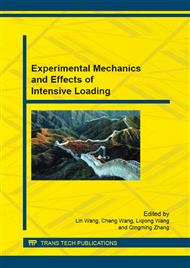[1]
Q. Yu, G. Jiang, S. Fu, Z. Chao, Y. Shang, and X. Sun, Fold-ray videometrics method for the deformation measurement of nonintervisible large structures, Appl. Opt. 48, 4683–4687 (2009).
DOI: 10.1364/ao.48.004683
Google Scholar
[2]
A. Martinelli and R. Siegwart, Observability properties and optimal trajectories for on-line odometry self-calibration, in Proceedings of the IEEE Conference on Decision and Control, San Diego, CA, Dec. 13–15, 2006, p.3065–3070.
DOI: 10.1109/cdc.2006.377161
Google Scholar
[3]
F. M. Mirzaei and S. I. Roumeliotis, A Kalman filter-based algorithm for IMU-camera callibration, in Proceedings of the IEEE/RSJ International Conference on Intelligent Robots and Systems, San Diego, CA, Oct. 29–Nov. 2, 2007, p.2427–2434.
DOI: 10.1109/iros.2007.4399342
Google Scholar
[4]
F. M. Mirzaei and S. I. Roumeliotis, A Kalman filter-based algorithm for IMU-camera calibration: Observability analysis and performance evaluation, IEEE Transactions on Robotics, 2008, (to appear).
DOI: 10.1109/tro.2008.2004486
Google Scholar
[5]
X. Brun and F. Goulette, Modeling and calibration of coupled fisheye CCD camera and laser range scanner for outdoor environment reconstruction, in Proceedings of the International Conference on 3D Digital Imaging and Modeling, Montreal, QC, Canada, Aug. 21–23, 2007, p.320.
DOI: 10.1109/3dim.2007.34
Google Scholar
[6]
Q. Zhang and R. Pless, Extrinsic calibration of a camera and laser range finder (improves camera calibration), in Proceedings of the IEEE/RSJ International Conference on Intelligent Robots and Systems, Sendai, Japan, Sept. 28–Oct. 2, 2004, p.2301.
DOI: 10.1109/iros.2004.1389752
Google Scholar
[7]
S. Wasielewski and O. Strauss, Calibration of a multi-sensor system laser rangefinder /camera, in Proceedings of the Intelligent Vehicles Symposium, Detroit, MI, Sept. 25–26, 1995, p.472–477.
DOI: 10.1109/ivs.1995.528327
Google Scholar
[8]
ZhANG Guang-jun and LI Xiu-zhi. Foot-Eye Calibration for Mobile Robots, ROBOT. 29, 230–233, (2007).
Google Scholar
[9]
Hesch JA, Mourikis AI, Roumeliotis SI. Determining the camera to robot-body transformation from planar mirror reflections. In: Proc. IEEE/RSJ int. conf. intel. robots syst. 2008. p.3865–71.
DOI: 10.1109/iros.2008.4651121
Google Scholar
[10]
Zhang Z Y. A flexible new technique for camera calibration[J] . IEEE Tranactions on Pattern Analysis and Machine Intelligence, 2002, 22( 11) : 1330 - 1334.
DOI: 10.1109/34.888718
Google Scholar
[11]
Kosuke Takahashi, Shohei Nobuhara, Takashi Matsuyama. A New Mirror-based Extrinsic Camera Calibration Using an Orthogonality Constraint, in Proceedings of the IEEE Conference CVPR, (2012).
DOI: 10.1109/cvpr.2012.6247783
Google Scholar
[12]
P. Sturm and T. Bonfort. How to compute the pose of an object without a direct view. In Proc. Of ACCV, pages 21–31, (2006).
DOI: 10.1007/11612704_3
Google Scholar
[13]
R. Rodrigues, P. Barreto, and U. Nunes. Camera pose estimation using images of planar mirror reflections. In Proc. Of ECCV, pages 382–395, (2010).
DOI: 10.1007/978-3-642-15561-1_28
Google Scholar
[14]
R. Kumar, A. Ilie, J. -M. Frahm, and M. Pollefeys. Simple calibration of non-overlapping cameras with a mirror. In Proc. Of CVPR, pages 1–7, (2008).
DOI: 10.1109/cvpr.2008.4587676
Google Scholar
[15]
J. A. Hesch, A. I. Mourikis, and S. I. Roumeliotis. Algo-rithmic Foundation of Robotics VIII, volume 57 of Springer Tracts in Advanced Robotics, chapter Mirror-Based Extrinsic Camera Calibration, pages 285–299. (2009).
DOI: 10.1007/978-3-642-00312-7_18
Google Scholar


